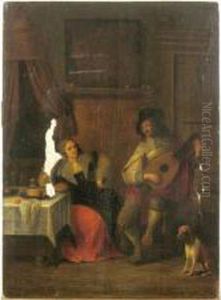Anthonie Palamadesz Paintings
Anthonie Palamedesz., also known as Anthonie Palamedes or Palamedeszoon, was a Dutch Golden Age painter, born in 1601 in Antwerp, in the Spanish Netherlands (now Belgium). His family moved to the Dutch Republic in the early 17th century to escape the Catholic Spanish rule. Anthonie's father, Palamedes Palamedesz, was also a painter, and his brother, Palamedes Palamedesz the Younger, followed in their father’s artistic footsteps. The family's relocation to Delft provided a nurturing environment for Anthonie's artistic development.
In Delft, Anthonie was influenced by the city's artistic community, and he probably trained with his father before joining the Guild of Saint Luke, a city guild for painters, in 1621. His work mainly focused on genre scenes, portraits, and historical subjects. Palamedesz is well known for his elegant genre scenes which often depicted the well-to-do citizens of Delft and their daily lives. His paintings are characterized by their lively and refined depiction of contemporary social gatherings, such as music parties, guardroom scenes, and cavaliers.
Anthonie Palamedesz's work was appreciated for its attention to detail, use of color, and the ability to capture textures of materials like silk and satin. He was also skilled in portraying the effects of light on different surfaces, adding depth and realism to his work. His portraits and group likenesses are marked by a certain stiffness, which was typical for the portraiture of that period, yet they still possessed a certain elegance that was characteristic of his style.
Throughout his career, Palamedesz enjoyed a successful career as an artist. His paintings were in demand, and he received commissions from various patrons, including the stadtholder of the Dutch Republic. In addition to painting, he was also involved in the local community, serving as a headman of the Guild of Saint Luke.
Anthonie Palamedesz died in 1673 in Amsterdam. His legacy is preserved in numerous works held in major museums and collections around the world, contributing to our understanding of the cultural and social life of the 17th-century Dutch Republic. Palamedesz’s paintings continue to be celebrated for their elegance and his ability to capture the essence of his time.
